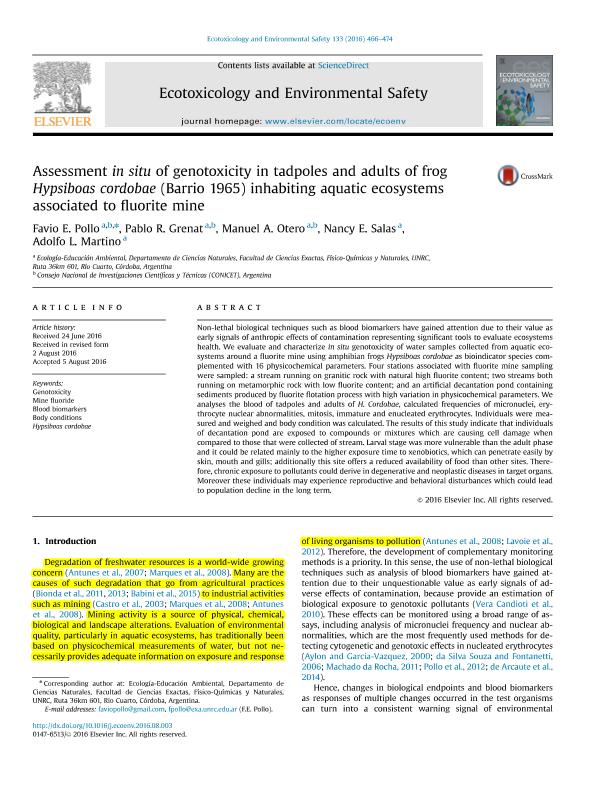Mostrar el registro sencillo del ítem
dc.contributor.author
Pollo, Favio Ezequiel

dc.contributor.author
Grenat, Pablo Raúl

dc.contributor.author
Otero, Manuel Alejandro

dc.contributor.author
Salas, Nancy Edith

dc.contributor.author
Martino, Adolfo Ludovico

dc.date.available
2022-06-22T14:30:37Z
dc.date.issued
2016-08
dc.identifier.citation
Pollo, Favio Ezequiel; Grenat, Pablo Raúl; Otero, Manuel Alejandro; Salas, Nancy Edith; Martino, Adolfo Ludovico; Assessment in situ of genotoxicity in tadpoles and adults of frog Hypsiboas cordobae (Barrio 1965) inhabiting aquatic ecosystems associated to fluorite mine; Academic Press Inc Elsevier Science; Ecotoxicology and Environmental Safety; 133; 8-2016; 466-474
dc.identifier.issn
0147-6513
dc.identifier.uri
http://hdl.handle.net/11336/160186
dc.description.abstract
Non-lethal biological techniques such as blood biomarkers have gained attention due to their value as early signals of anthropic effects of contamination representing significant tools to evaluate ecosystems health. We evaluate and characterize in situ genotoxicity of water samples collected from aquatic ecosystems around a fluorite mine using amphibian frogs Hypsiboas cordobae as bioindicator species complemented with 16 physicochemical parameters. Four stations associated with fluorite mine sampling were sampled: a stream running on granitic rock with natural high fluorite content; two streams both running on metamorphic rock with low fluorite content; and an artificial decantation pond containing sediments produced by fluorite flotation process with high variation in physicochemical parameters. We analyses the blood of tadpoles and adults of H. Cordobae, calculated frequencies of micronuclei, erythrocyte nuclear abnormalities, mitosis, immature and enucleated erythrocytes. Individuals were measured and weighed and body condition was calculated. The results of this study indicate that individuals of decantation pond are exposed to compounds or mixtures which are causing cell damage when compared to those that were collected of stream. Larval stage was more vulnerable than the adult phase and it could be related mainly to the higher exposure time to xenobiotics, which can penetrate easily by skin, mouth and gills; additionally this site offers a reduced availability of food than other sites. Therefore, chronic exposure to pollutants could derive in degenerative and neoplastic diseases in target organs. Moreover these individuals may experience reproductive and behavioral disturbances which could lead to population decline in the long term.
dc.format
application/pdf
dc.language.iso
eng
dc.publisher
Academic Press Inc Elsevier Science

dc.rights
info:eu-repo/semantics/openAccess
dc.rights.uri
https://creativecommons.org/licenses/by-nc-sa/2.5/ar/
dc.subject
BLOOD BIOMARKERS
dc.subject
BODY CONDITIONS
dc.subject
GENOTOXICITY
dc.subject
HYPSIBOAS CORDOBAE
dc.subject
MINE FLUORIDE
dc.subject.classification
Conservación de la Biodiversidad

dc.subject.classification
Ciencias Biológicas

dc.subject.classification
CIENCIAS NATURALES Y EXACTAS

dc.title
Assessment in situ of genotoxicity in tadpoles and adults of frog Hypsiboas cordobae (Barrio 1965) inhabiting aquatic ecosystems associated to fluorite mine
dc.type
info:eu-repo/semantics/article
dc.type
info:ar-repo/semantics/artículo
dc.type
info:eu-repo/semantics/publishedVersion
dc.date.updated
2022-06-21T18:37:44Z
dc.journal.volume
133
dc.journal.pagination
466-474
dc.journal.pais
Estados Unidos

dc.journal.ciudad
Amsterdam
dc.description.fil
Fil: Pollo, Favio Ezequiel. Universidad Nacional de Río Cuarto. Facultad de Ciencias Exactas Fisicoquímicas y Naturales. Departamento de Ciencias Naturales. Cátedra de Ecología; Argentina. Consejo Nacional de Investigaciones Científicas y Técnicas; Argentina
dc.description.fil
Fil: Grenat, Pablo Raúl. Consejo Nacional de Investigaciones Científicas y Técnicas; Argentina. Universidad Nacional de Río Cuarto. Facultad de Ciencias Exactas Fisicoquímicas y Naturales. Departamento de Ciencias Naturales. Cátedra de Ecología; Argentina
dc.description.fil
Fil: Otero, Manuel Alejandro. Consejo Nacional de Investigaciones Científicas y Técnicas; Argentina. Universidad Nacional de Río Cuarto. Facultad de Ciencias Exactas Fisicoquímicas y Naturales. Departamento de Ciencias Naturales. Cátedra de Ecología; Argentina
dc.description.fil
Fil: Salas, Nancy Edith. Universidad Nacional de Río Cuarto. Facultad de Ciencias Exactas Fisicoquímicas y Naturales. Departamento de Ciencias Naturales. Cátedra de Ecología; Argentina
dc.description.fil
Fil: Martino, Adolfo Ludovico. Universidad Nacional de Río Cuarto. Facultad de Ciencias Exactas Fisicoquímicas y Naturales. Departamento de Ciencias Naturales. Cátedra de Ecología; Argentina
dc.journal.title
Ecotoxicology and Environmental Safety

dc.relation.alternativeid
info:eu-repo/semantics/altIdentifier/url/https://pubmed.ncbi.nlm.nih.gov/27522316/
dc.relation.alternativeid
info:eu-repo/semantics/altIdentifier/doi/https://doi.org/10.1016/j.ecoenv.2016.08.003
Archivos asociados
